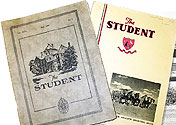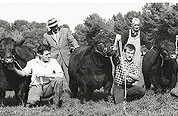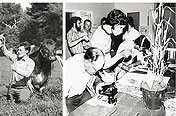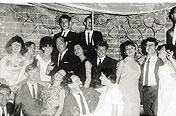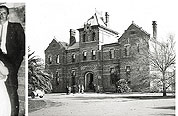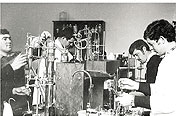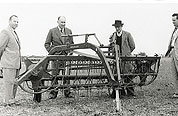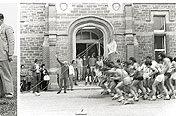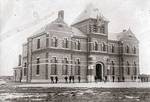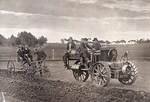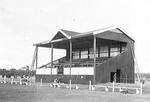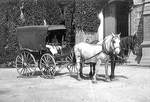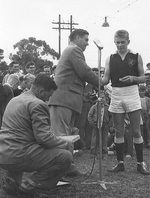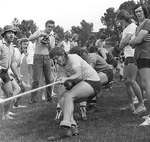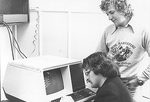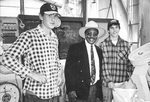Roseworthy celebrates 125 years
The University of Adelaide's Roseworthy Campus will host a series of special events over six weeks to celebrate its 125th birthday and showcase its vision for the future.
The Campus, which began as Roseworthy Agricultural College in 1883, was Australia's first college devoted to agriculture and agricultural science.
On Saturday 18 October, a non-denominational service will be held in majestic St Peter's Cathedral at 11am, followed by a graduation re-enactment ceremony in Bonython Hall at 3pm. This includes the presentation of the Roseworthy Old Collegians Association (ROCA) Commemorative Awards of Merit and Humanitarian awards.
Later that evening a celebratory dinner will take place at the Pavilion (Adelaide Oval) acknowledging Roseworthy's longstanding involvement in agricultural education and research, with an exhibition of archival photographs, a silent auction of heritage football guernseys and the announcement of the 2008 ROCA Award of Merit recipient.
Current and former staff and Council members will be invited to a reunion at the Roseworthy Campus on Sunday 26 October, while Natural Resources graduates (1976-1980) will get together at the Adelaide Oval Pavilion for a reunion cocktail function on Saturday 1 November.
The following day, on Sunday 2 November, the Roseworthy Campus will hold a special Open Day, featuring the theme, "The Science Behind the Product".
Campus Director Professor Phil Hynd said the Open Day would showcase Roseworthy's future while celebrating its history, and would focus on agricultural systems, animal production and veterinary science.
"Over its 125 year history, Roseworthy has developed an international reputation for excellence in research and teaching in dryland agriculture, natural resources management, winemaking and animal production," Professor Hynd said.
"A new vision has been developed for the campus into the 21st century. We aim to combine internal expertise and external resources to make the campus a hub for information transfer, commercialisation, education and research to service the agricultural industries for the next 125 years."
Professor Hynd said research and teaching excellence were critical in achieving these goals.
"Already the campus is home to the State Government's Constellation in Animal Science, a 10-year vision for science, technology and innovation in South Australia.
"Roseworthy is also a major player in five Cooperative Research Centres - pork, poultry, sheep, beef and bioremediation - and a participant in overseas development aid programs
in India, China and Tibet."
This year Roseworthy is also celebrating the launch of the State's first veterinary science school, accepting 50 students in the inaugural 2008 intake.
To ensure research and teaching are conducted in a real-world context, commercial partners are encouraged to make Roseworthy their home base.
These include Australian Grain Technologies Pty Ltd, the largest cereal breeding company in Australia, which has made Roseworthy the centre of its national operations.
The last link in the chain is to develop a seamless transition of education from secondary school to TAFE, and to University.
"Secondary school students are already spending time on the campus using the `field classroom' to bring science to life," Professor Hynd said. "It is envisaged that a permanent secondary school presence will ultimately be established at Roseworthy with an emphasis on science and agriculture."
The Roseworthy Open Day on Sunday 2 November will be held from 11am-5pm and will include exhibits, talks, food, entertainment and family activities.
Story by Candy Gibson
A brief history of Roseworthy
Low agricultural yields and a reliance on imported seed gave impetus to the establishment of Australia's first agricultural college at Roseworthy in the late 1800s.
A growing population in South Australia meant there was also an urgent need for new plant varieties more suited to the State's climate and soils.
Roseworthy Agricultural College was established in 1883 and John Daniel Custance was appointed the first Professor of Agriculture.
The genesis of Roseworthy was Olive Hill Farm, a 335 hectare property purchased for six pounds an acre. Custance started a rainfall register, analysed the soil and acquired dairy cattle, sheep and pigs to make the farm self-supporting. He also planted a total of 180 experimental wheat varieties collected from five continents, 157 manurial substances and 520 types of fodder plants.
Despite modest beginnings, Custance set extremely high standards in the area of education, experimental work and research, which future principals were to emulate.
A measure of the high academic standard set was the inclusion of Roseworthy subjects in Agriculture, Viticulture and Oenology and associated practical work as part of the Bachelor of Science offered by the University of Adelaide in the early 1900s. A formal affiliation between the two parties was reached in December 1905.
Despite the difficulties of drought, the Great Depression and the resulting decline in student numbers, the College managed to build a reputation as an important agricultural institution for research and education.
Cereal plant breeding received national recognition, as did the newly established Animal Research Unit, and significant advancements were made in farm, livestock, dairy, sheep and horse management.
After the appointment of Allan R. Callaghan as Principal in 1932, the College reaffirmed its role as a training centre for agricultural technologists and the relationship with the University strengthened. Graduates from Roseworthy could complete the B.Ag.Sc. in three years instead of four and University students spent the second year of their course at Roseworthy to get practical experience.
In 1936 the Diploma in Oenology was established and the success of that course and its graduates generated a lot of esteem for the College.
The onset of the Second World War impacted on Roseworthy as a number of staff and students joined the armed forces. During the 1950s an appeal was launched and the Memorial Chapel was built to commemorate those who had died on active service.
In 1974 Roseworthy became a College of Advanced Education. There followed a significant increase in student numbers, staff and courses, with new programs in wine marketing, farm management, agricultural husbandry and natural resources.
Informal discussions between the College and University started in 1988 regarding a formal partnership between the institutions. In 1991 the College merged with the University and became known as the Roseworthy Campus.
In 2007 the University received State and Federal Government approval for the State's first veterinary school, to be established at Roseworthy, with 47 students enrolling in the inaugural 2008 intake.
Roseworthy Campus's strengths today are in dry land agriculture, animal science, plant breeding, and environmental teaching and research.
Material sourced from University of Adelaide Archives volunteers.
|





